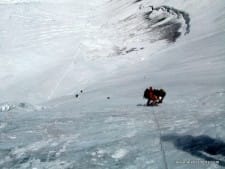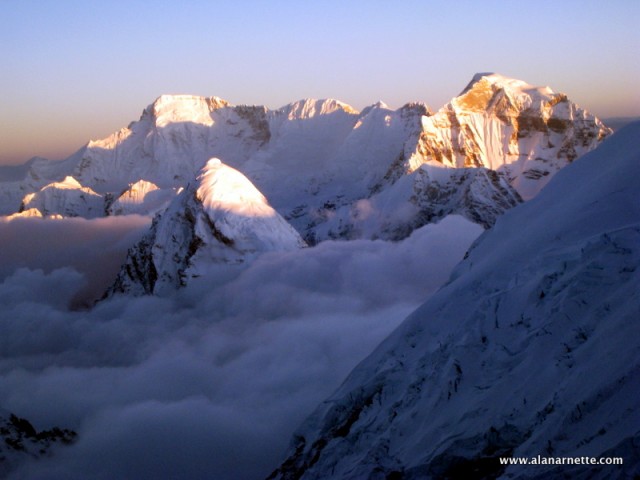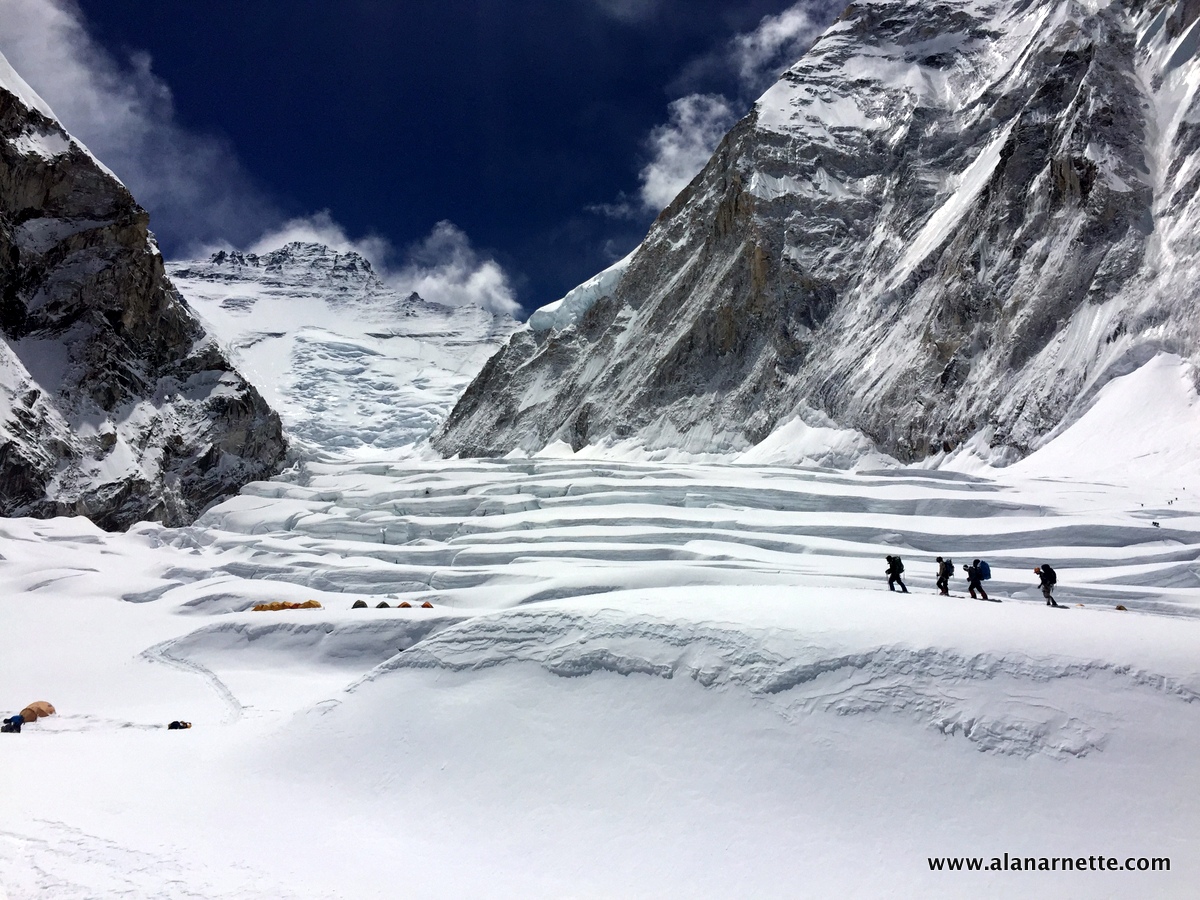“All dressed up and nowhere to go” may be the best current summary of Everest. High winds from Camp 3 at 23,000 feet or 7,000 meters and above is the culprit. However, there were rare summits on Nuptse and a good effort on Nuptse.
Last Week
Despite the high winds, teams continued to do acclimatization rotations up to Camp 3 at 7,000 meters. Most are ready for their summit bids, with some taking a vacation from their vacation in Namche or even Kathmandu.
Colorado-based meteorologists Chris Tomer of Tomer Weather Solutions is providing custom forecasts for several teams in the Himalayas this spring. He thinks the current bad weather will relent after May 10, and the first weather window long enough to reach the summit will be May 13 through 17, perhaps even to May 20. He goes on to tell me that it’s due to a jet streak, not the jet stream:
Jet is powerful right now because it’s a jet streak translating through. Jet streaks are pockets of very high winds. They tend to develop because they’re sandwiched in-between two intense pressure features. Currently, there’s a large dome of high pressure over southern India/Indian Ocean and a large area of lower pressures over China. That forces the wind to howl at high atmospheric levels.
The fixed ropes are stalled at the South Col, and no team has stocked their camps there for the summit bid, so there is a lot of work remaining. I suspect the Sherpas will get the ropes to the summit around May 11 to 13, followed by the first wave of climbers, mostly from the Nepali operators. I also suspect that Kenton Cool will be among the first.
If you’re curious about the earliest and latest Everest summits, well, the earliest summits by the rope team and members were May 5, 2009, and 2010 and the latest was May 18 in 2012.
Differing Heights
It seems my mention that the Icefall route was long, as in nine miles measured on a Garmin watch, created some discussion. I’ve received several other measurements from 2.8, 3.04, and 3.61 to 5.5 miles. Hmmm.
Hemorrhoids on Everest
Over at EverestER, the volunteer medical clinic at Everest Base Camp, they report seeing over 350 patients, mostly for the Khumbu Cough. Their report:
A few stats from our hard working Everest ER team: since opening we’ve had over 350 patient visits. The majority of our patients, as expected (70%) are Nepali. Following the trend of the past 20 years, the number 1 complaint from our patients is respiratory illness, and our diagnoses include high altitude cough, viral respiratory infection, pneumonia, bronchitis, HAPE, asthma among others. Hemorrhoids and orthopedic injuries round out the top 3. We’ve evacuated or participated in the evacuation of 7 patients. As teams acclimatize higher and prepare for summit bids, we’ll try our best to keep them in good shape for the climb.
Nuptse
Everest climbers are always nearby this nearly 8000-meter peak (it’s 7,861 m (25,791 ft)) as it defines the right side of the Western Cwm. Teams rarely reach the true summit because it’s heavily corniced and extremely dangerous. The HDB reports only 22 summits from 1950 to 2022. But last week, two climbers (Krisli Estonia and Richard Draves) plus Garrett Madison, supported by six Sherpas (Aang Phurba Sherpa, Mingdorchi Sherpa, Chheder Sherpa, Lakpa Sherpa, Dawa Tenji Sherpa and Chheten Dorjee Sherpa) summited on May 8, significantly growing that summit total.
While Nepal has issued 63 permits to six teams, I’m told that many of those climbers will go to Camps 2 or 3 and not Nuptse. You need a climbing permit to go above base camp, and a Nuptse permit costs $600 compared to $11,000 for Everest.
Ama Dablam
There was a large avalanche from the Dablam on Ama. No one was injured. This is not unusual and is becoming more frequent.
Pumori
This mountain was avoided for years due to avalanche potential but recently has regained popularity. A small team attempted it this year but turned back near the summit due to the risks.
Next Week
With a record number of clients on Everest this year, I was concerned about crowding, however, everyone I speak to says the mountain doesn’t feel crowded.
Granted, many people have left base camp for “touch-grass” holidays in Namche and Kathmandu, and reportedly there has already been a significant amount of attrition, perhaps as high as 30%. So this would reduce the overall number of people on Everest when the summit push begins in earnest.
So are we looking at a window like last year with almost the entire month of May suitable to summit? No, that ship has sailed already. The ropes might not make it to the summit until May 13 at the earliest. So will it be like 2019 with only three suitable summit days? Probably not, given what Tomer forecasted. So we have more of a historically normal season, albeit with the late first summits.
Nepal RECORD Permit Update as of May 7, 2023
The permits for Everest are leveling out, albeit at a record of 467. The previous Everest record was 408 for the 2021 season of 408. Climbing permits have been issued for 1,123 climbers from 80 countries for 27 peaks. Looking at Everest only, China has the largest representation with 96 members, followed by the US at 87, India–at 40, Canada-21, and Russia-20. There are 44 countries represented by three or fewer climbers.
These permits have generated $5.6M in royalties for the government. Almost all of this revenue stays in Kathmandu, with some in various personal pockets and none to the Sherpas, porters, or other high-altitude workers. The Nepal Ministry of Tourism posted these foreign permit tally as of April 28, 2022:
- Everest: 467 on 44 teams
- Ama Dablam: 79 on 8 teams
- Annapurna I: 54 on 5 teams
- Dhaulagiri: 35 on 3 teams
- Himlung: 41 on 5 teams
- Kanchenjunga: 42 on 4 teams
- Lhotse: 126 on 14 teams
- Makalu: 58 on 7 teams
- Manaslu: 15 on 4 teams
- Nuptse: 63 on 6 teams
With teams now going higher, let’s look at what it takes to climb the Lhotse Face.
Climbing the Lhotse Face
There is no Easter Bunny, no Santa Claus; the Grimm Brothers’ fairy tales are dark and scary, and magic is real. Today, everyone on Everest believes in magic.
Sitting in your tent at Camp 2, 21,500 feet, you rub the sleep out of your eyes. Your headlamp betrays your cold breath at 3:00 AM. Today you climb the Lhotse Face.
The morning routine is annoyingly familiar. It takes ten times longer than when you were back home to put on your boots. Breakfast is simple – toast, maybe an egg, perhaps hot cereal, and coffee. The Sherpa cooks have been up since 1:00 AM heating water so you eat with gratitude. But really, all you want to do is crawl back into your warm sleeping bag.
Sitting silently in the dining tent, your curse the tiny golf chairs for their instability, but then you consider where you are and are glad to have anything to sit on. Taking the last sip of coffee, you turn on your headlamp.
Stepping out of the tent, you kneel to put on your crampons but then look up. The moon is lighting up the ‘Face’. It looks huge. Squinting, you look for Camp 3; maybe you see it, but probably not. Finishing your crampon work, you take another deep breath.
The walk to the base of the Lhotse Face is familiar; you did this a few days ago to get some exercise. But that was in the daylight, now in the dark; it seems to go on forever. You don’t remember the elevation gain and find yourself breathing hard once again. The morning blues…
Approaching the base, you glance at your watch, which took an hour. Once again, you look up. Now all you see is snow and ice. Bending over, you clip your carabiner and jumar onto the white nylon rope – that is your lifeline. With an ice axe in the other hand, you begin.
The first section seems steep, but you have read all about the Lhotse Face, so this is not a surprise. But it is steep, seriously steep; not quite what you were expecting. OK, it should ease shortly – you try to convince yourself. At least, that is how it looked from Camp 3.
 Icy Lhotse Face
Icy Lhotse FaceNow two hours in, your mind wanders. You hear the voices of those back home when you told them you were going to Everest. The negative surfaces: “why, are you crazy, glory er, rich spoiled brat, peak bagger, selfish, …”
The naysayers were loud but not to your face. You heard them; you know what some people say about those who climb Everest. You fight to keep the voices from growing into doubts. You know why you are here, who believes in you, your belief in yourself.
Glancing up from your feet, you now see the Lhotse Face up close. The ice is hard, translucent, and blue. You stare at your crampon front points. “Damn, I wish they were sharper,” you mumble out loud. The wind picks up, blowing a bit of snow in your face. Actually, you don’t mind; it takes you away from the dark thoughts.
Looking around, you see a few of your teammates. The Sherpas seem like they are everywhere. You are on the up rope. There is another rope to your left, the down rope. They seem to go on forever. You are careful not to put your weight on the rope; that is not the purpose. They are there to stop a fall, not to get you up the hill, but you cheat.
Once again, the voices are loud. But real this time. You step to your right to let a few faster climbers go by. Once again, a high-altitude ballet.
You are attached to the line by two thin strips of nylon, webbing. They are attached to a carabiner and a jumar. The jumar has small teeth going in one direction that will catch you if you fall in the opposite direction. A golden rule is to always stay attached to the rope.
 You make eye contact with the other climber. No words are spoken; perhaps a nod is exchanged. She unclips her ‘biner while keeping the jumar attached. She reaches around you to clip the ‘biner back onto the rope ahead of you. You stand still, not wanting to make any movement that might throw both of you off balance.
You make eye contact with the other climber. No words are spoken; perhaps a nod is exchanged. She unclips her ‘biner while keeping the jumar attached. She reaches around you to clip the ‘biner back onto the rope ahead of you. You stand still, not wanting to make any movement that might throw both of you off balance.
She takes a few small steps around you and reaches back to unclip the jumar. Successfully past you, the slow obstacle, she reattaches the jumar and climbs higher. You stand staring, not sure whether to be impressed or depressed.
Once again focused on your own climb, you see the trail ahead, steps kicked into the hard face. You are grateful now for the traffic on the Lhotse Face. There are small buckets in the ice to plant your feet. Somehow the steps provide a placebo that it will be easy to reach Camp 3, 23,500 feet. The steps are few and far between, loose and soft, and unreliable today; maybe they will be different next time up. You are on a steep, slick mountainside that requires constant concentration.
More steps, more clips. The fixed rope is attached to the earth every few hundred feet. Each anchor requires a series of actions. You are glad you spent the extra money on the good gloves.
 Camp 3 Lhotse Face
Camp 3 Lhotse FaceYour down jacket has felt good, but now with the sun rising over the summit of Lhotse, you begin to think about layers. Great, now you are getting a bit warm. OK, it feels good but not too much warmth. You are never satisfied, are you?
As usual, the tents ahead appear out of nowhere. The climb thus far has been a series of steep sections followed by a short flat spot – a cruel trick. You took your breaks, ate, and drank; you are actually doing well. But the tents are a welcome sight.
Wait, there are three Camp 3s! Another cruel trick. The Face is too steep to put all the tents needed in one spot. Yours is the highest. This irony is good news, bad news. Today you suffer, but on the summit push, you will have an advantage.
Passing other tents, you see fellow climbers in their tents. You smile at them and curse under your breath. Jealously fuels your steps higher. Actually, no one is watching you, but your vanity runs wild. You stiffen your back. You focus on your form. Step, plant the ice axe, step, move the ‘biner, step, move the jumar, stand up straight, look ahead, smile for the camera!
Passing the last of the tents, you now only see a high bump in the ice. If you were home, where you trained, you would pass this is a matter of minutes, maybe seconds. But at 23,600 feet, you stop and stare once again. Breathing heavily, you muster whatever is left and take a few more steps. Higher, slower; the climb is taking a toll on your body. You no longer look anywhere but at your feet, interrupted by a short glance at the next anchor. Your style is zombiesque.
A familiar voice calls out your name. A Sherpa from your team. He waves you with enthusiasm towards the yellow tent. Stepping carefully through a maze of lines, you slowly move toward him. You have no choice but to move slowly. You are nakered.
 View from Camp 3 on Lhotse Face
View from Camp 3 on Lhotse FaceFinally, reaching your tent. You collapse in a down-covered heap. The poor goose who made the donation would not be proud. Careful with your crampons; you finally swing around to see where you are. Your breathing continues to be heavy. You have the hundred-yard stare. A bit of water helps begin the recovery. Your head bobs.
Slowly you come around. Your mind thinks like you are texting with a simple OMG. It is justified. The scene before you defy words. OMG. Slowly your eyes trace the perimeter: Nuptse to your left, The Western Cwm front and center, Everest to the right.
Are you really there? Again you scan the view. Now you see Pumori. It looks tiny. It dominates your view at Base Camp. What happened – you are more than a mile higher, that’s what happened.
On the horizon, you spot Cho Oyu, the world’s 6th highest peak. You recognize the flat summit plateau. Maybe that will be next. You are thinking clearly now or not.
More water. Your breathing is slow. Your heart is steady. You are in control.
Sitting there on the snow-covered Lhotse Face, it sinks in that you are climbing Everest, well, Lhotse, technically. But you glance over your right shoulder and see the massive shoulder of the world’s highest mountain.
This cannot be real. It must be magic.
 Cho Oyu from Camp 3 on the Lhotse Face
Cho Oyu from Camp 3 on the Lhotse Face
Climb On!
Alan
Memories are Everything
The Podcast on alanarnette.com
You can hear #everest2022 podcasts on Spotify, Apple Podcast, Google Podcasts, Pocket Casts, RadioPublic, Anchor, and more. Just search for “alan arnette” on your favorite podcast platform.
Why this coverage?
I like to use these weekend updates to remind my readers that I’m just one person who loves climbing. With 37 serious climbing expeditions, including four Everest trips under my belt and a summit in 2011, I use my site to share those experiences, demystify Everest each year and bring awareness to Alzheimer’s Disease. My mom, Ida Arnette, died from this disease in 2009, as have four of my aunts. It was a heartbreaking experience that I want no one to go through; thus, I ask for donations to non-profits where 100% goes to them and nothing ever to me.
![]()

Summit Coach
If you dream of climbing mountains but are not sure how to start or reach your next level, from a Colorado 14er to Rainier, Everest, or even K2, we can help. Summit Coach is a consulting service that helps aspiring climbers throughout the world achieve their goals through a personalized set of consulting services based on Alan Arnette’s 25 years of high-altitude mountain experience, including summits of Everest, K2, and Manaslu, and 30 years as a business executive.




